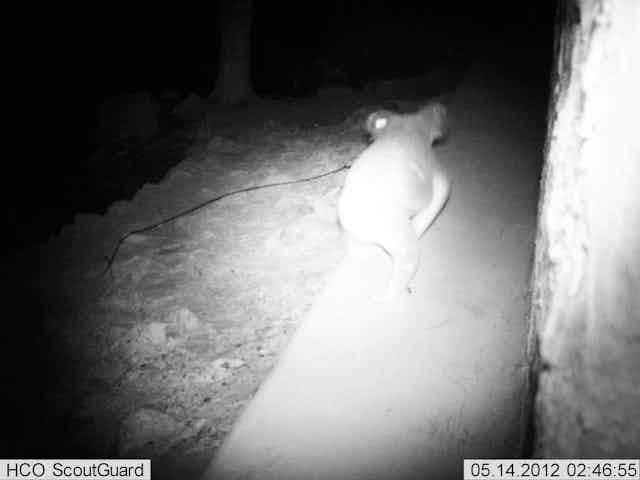It’s obviously feel-good, family-friendly marketing, but the brutal reality is those “Sugar Glider Road”, “Wallaby Close” and “Fairy Wren Circuit” street signs are almost certainly memorials for absent friends rather than indicators of cherished co-residents.
As was so disturbingly articulated by wildlife veterinarian Dr Jon Hanger on Four Corners August 20, when we clear bushland the wildlife doesn’t just move on. In almost all cases most of the lizards, mammals, small birds and koalas will die, either immediately during the destruction of their habitat, or eventually due to exposure to predators, lack of food or the sheer stress associated with losing their environment. And this kind of wildlife death is specific to Australia: in other countries, suburban sprawl moves over already-transformed rural landscapes. Here, it often envelopes the surrounding forest.
Although fairly tentative and inconclusive, the Four Corners program did highlight the complexity and inevitability of the impact urbanisation has on biodiversity, with the spotlight understandably focused on the tragically cute koala. The recent Federal Government listing of the species as “threatened” in Queensland, New South Wales and the ACT will apparently mean far greater scrutiny of activities that harm koalas or their habitat. The operationalisation of such a process is far from clear, but the cry of “yet more green tape” can already be heard from developers and certain state government ministers.

Koalas and people share the same tastes in location, though not lifestyle. In coastal eucalypt woodlands and forest throughout the eastern seaboard, people are scrambling for spanking-new house blocks in vast new estates carved directly from the “vacant” bushland.
In the new suburbs surrounding Port Macquarie, Coffs Harbour, the Gold Coast and the Redlands of south-east Queensland, this is having a predictably catastrophic effect on the local, relatively abundant koala populations. Specialised koala hospitals and centres now operating in these locations all reported large numbers of koalas admitted because of injuries from vehicles, attacks by dogs and a variety of debilitating diseases. In some of these areas, the rate of these admissions has started to wane, principally because the numbers of local koalas have declined significantly.
The best data on koala population trends comes from the “Koala Coast” area of southern Queensland. Here, sizeable tracts of eucalypt forest were set aside for koala conservation in the 1980s (following vehement opposition to plans for new motorways through the areas). As part of the Queensland Government’s ongoing monitoring of these koala populations, we now have a depressingly clear picture of a species declining to extirpation. And it’s the expected urban pressures: loss of habitat, cars, dogs and disease.
Each of these factors is being addressed, though in certain places, to a limited extent, and with mixed results. Domestic dog management is being talked about, seemingly seriously, though no one actually expects any real changes there. (Bear in mind that an appallingly high proportion of the koalas translocated from Coomera on the Gold Coast have been killed by apparently “feral” dogs.)
Koalas appear to carry a remarkable cocktail of diseases and pathogens, often without showing any symptoms. Urban koalas, however, may be more susceptible to these ailments when subjected to the chronic stress of living in human-dominated landscapes. Wildlife disease experts are investigating diseases throughout the distribution of the species. There is hopeful work toward a vaccine for the most prevalent of all koala afflictions, chlamydia. As any of these researchers are quick to admit, however, we shouldn’t expect quick answers to this exceptionally complex picture.

Perhaps unexpectedly, one area showing surprisingly positive signs is reducing road causalities among roaming koalas. Unlike many species of wildlife - which shun roads and retreat further into the bush far from traffic disturbance - koalas are notorious for attempting to cross even major roads in search of favoured feed trees or a potential liaison.
To reduce the risk of koala road-kill, major local authorities and state agencies have been busy constructing specially designed exclusion fences to stop animals reaching the road. However, for koalas now living in an increasingly fragmented landscape of bushland patches often separated by roads, it is critically important that they are able to move from patch to patch safely.
To help koalas safely cross busy roads, Queensland Transport and Main Roads have been working with ecologists to install structures under bridges and in large culverts. But like many animals, koalas are highly reluctant to walk through water. To provide a dry alternative route under the road, a number of box culverts have been retrofitted: broad ledges are attached to the wall of the culvert with platforms leading from the land on either side of the road. Despite significant skepticism and jokes about whether “eucalyptus addicts” are capable of learning to do something no koala has ever needed to do before, the first animals were using the ledges within weeks and have continued to do so.
The enduring issue for urban koalas is, of course, whether people and koalas can actually coexist in the same environment. Depending on your perspective, it can be either a marvelous discovery or a “bloody nuisance” to have a koala visit the tree in your suburban backyard.

